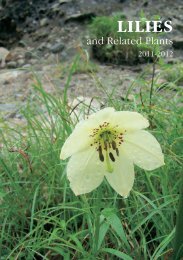LILIES - RHS Lily Group
LILIES - RHS Lily Group
LILIES - RHS Lily Group
You also want an ePaper? Increase the reach of your titles
YUMPU automatically turns print PDFs into web optimized ePapers that Google loves.
June to the end of July.<br />
Lilium martagon is easily recognised by the whorled lower and middle leaves<br />
and the rather numerous flowers borne in an extended raceme. Plants from<br />
central Europe have pale, usually spotted flowers and glabrous buds. Many of<br />
the Greek plants have rather dark flowers which are either uniformly brownishpurple<br />
or have indistinct raised spots; the flower buds are lanate, i.e., have<br />
long soft woolly hairs. Such plants have been called var. cattaniae or var.<br />
sanguineo-purpureum, but it is not clear whether all Greek plants share these<br />
features. Observations on variation in and between the Greek populations would<br />
be welcome.<br />
4. Lilium chalcedonicum<br />
The native distribution of this bright scarlet lily is probably restricted to Greece<br />
and S Albania, although species with a similar flower colour occur elsewhere, e.g.<br />
L. pomponium in the Maritime Alps (see pp. 24). Being a spectacular species it was<br />
taken into cultivation early, and pictures undoubtedly showing L. chalcedonicum<br />
appear in German Kräuterbücher from the sixteenth and seventeenth century; it<br />
is likely to have come to central Europe via Turkey.<br />
Lilium chalcedonicum occurs in somewhat damp, semi-shaded, rocky places<br />
in open deciduous woods, Buxus scrub and meadows, generally between<br />
600 and 1700 m and usually on limestone. It is rarely found in large quantity<br />
except maybe on Mt Iti in Sterea Ellas where I have observed large and healthy<br />
populations. It flowers late, generally from mid-July to mid-August. The tepals are<br />
generally bright and uniformly scarlet and strongly recurved with long papillae<br />
towards the base; also the anthers are bright scarlet. Slightly paler forms with<br />
indistinct spots are found occasionally.<br />
Some authors including Halácsy (Conspectus Florae Graecae) and Hayek<br />
(Prodromus Florae Peninsulae Balcanicae) have regarded Lilium heldreichii as<br />
specifically distinct from L. chalcedonicum, differing in the consistently 1-flowered<br />
stem, lower leaves less crowded and wider, and leaves abruptly decreasing in<br />
size up the stem. Differences have also been cited in shape of bulb scales and<br />
stigma. Turrill (<strong>Lily</strong> Year Book 17: 34-36, 1954) examined fairly abundant material<br />
and came to the conclusion that there are no consistent differences. Having<br />
studied plants both in the field and in cultivation I fully agree with this view.<br />
In nature L. chalcedonicum is generally 35-70 cm tall and has 1-3 or occasionally<br />
up to 4 flowers. Transplanted into good garden soil and grown in semi-shade<br />
they may be around 100 cm tall and develop up to 12 flowers. Three bulbs<br />
were transplanted from a population on Mt Olympus in 1975 to the Copenhagen<br />
Botanical Garden and subsequently to my private garden north of Copenhagen<br />
where they were grown successfully for 25 years. The bulbs could be divided<br />
23




